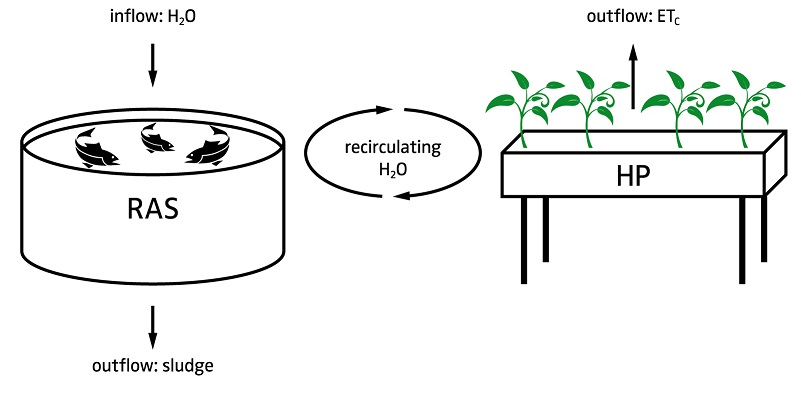Whether decoupled Aquaponics (DAPS: Decoupled Aquaponics System) has a general advantage over conventional recirculating aquaponics systems is much debated on the internet and in academia. Finding this out has been our goal over the last few years and led to the publication "
Navigating Decoupled Aquaponics Systems: A system dynamics design approach ". Following the KISS principle (Keep it simple, stupid!), I will briefly outline the main points of the publication and discuss them a bit in non-scientific jargon (without the abstract of the paper).
| DAPS |
Decoupled Aquaponics System ( Entkoppeltes Aquaponiksystem ) |
| HP |
Hydroponik |
| RAS |
Rezirkulierendes Aquakultur System |
Abstract
The classic working principle of aquaponics is to supply a hydroponic plant culture unit with nutrient-rich aquaculture water, which in turn purifies the water that is returned to the aquaculture tanks. A known drawback is that a compromise away from optimal growing conditions for plants and fish must be achieved to produce both crops and fish under the same environmental conditions. The aim of this study was to develop a theoretical concept of a decoupled aquaponics system (DAPS) and predict water, nutrient (N and P), fish, sludge and plant values.
This was addressed by developing a dynamic aquaponic system model using inputs from data in the literature covering aquaculture, hydroponics and sludge treatment. The results of the model showed the dependence of aquaculture water quality on hydroponic evapotranspiration rate. This result can be explained by the fact that DAPS is based on one-way flows. These one-way flows lead to accumulations of remineralised nutrients in the hydroponic component, which ensure optimal conditions for the plants. The study also suggests sizing the cropping area based on P availability in the hydroponic component, as P is a depletable resource and has been identified as one of the most important limiting factors for plant growth.
Decoupled aquaponics
Although many aquaponics systems are designed and operated as recirculating systems, commercial growers and researchers are expanding this initial aquaponics system design to include independent control over each system unit (i.e. RAS, hydroponics and nutrient recovery through sludge remineralisation: recirculated aquaculture systems).
Decoupled aquaponics systems (DAPS) are systems in which fish, plants and, where appropriate, remineralisation are integrated as separate functional units consisting of individual water circuits that can be controlled independently. The difference between the concepts of one-loop and multi-loop (i.e. decoupled) aquaponics systems can be seen in Figures 1 and 2. In the context of recycling all nutrients entering the system, decoupled aquaponics can be seen as a preferred option as they avoid additional discharge.

Abb. 1 - The one-loop aquaponics system is the traditional aquaponics approach. Instead of supplementing the hydroponic part with fertiliser, both components are exposed to quite similar conditions

Abb. 2 - In contrast to a single-loop aquaponics system, a multi-loop aquaponics system aims to create optimal conditions for both fish and plants. In this case, the fish sludge coming from the RAS is remineralised and fed to the hydroponics.
Figure 3 shows a process flow drawing of a basic DAPS layout. Please note - this is only an example and can be adapted in a modular way. The blue tags in the figure include the RAS component, the green tags include the hydroponic component and the red tags include the remineralisation components. The sequence of the components is represented numerically in the tags and refers to the vertical direction in which the flow must move.
This means that high numbers refer to high positioning and low numbers to low positioning.
Während RAS (Rezirkulierten AquakulturSysteme) und Hydroponik seit Jahrzehnten Gegenstand der Forschung sind, steckt die Remineralisierung von Fischschlamm noch in den Kinderschuhen. In der Abhandlung haben wir die Vor- und Nachteile der aeroben Vor- und Nachbehandlung der anaeroben Vergärung diskutiert, derzeit untersuchen wir jedoch die Leistung der reinen anaeroben Vergärung. Wir werden Sie auf dieser Website über unsere Ergebnisse auf dem Laufenden halten.
Leider müssen wir alle enttäuschen, die sich dafür begeistert haben, ein entkoppeltes Aquaponik-System in ihrem Garten zu bauen. Entkoppelte Aquaponiksysteme erfordern viel Steuerungstechnik und sind nur sinnvoll, wenn man bereit ist, hohe Nährlösungen in der Hydrokultureinheit zu erzielen. Außerdem ist die Dimensionierung des Systems im Vergleich zur Dimensionierung herkömmlicher Systeme mit einer Schleife viel komplexer. Die Ermittlung der erforderlichen Evapotranspirationsrate der hydroponischen Pflanzen, die erforderlich ist, um eine Akkumulation von Stickstoffformen im RAS zu vermeiden, erhöht die Komplexität zusätzlich. Folglich sind diese Art von Systemen am besten für kommerzielle Systeme im großen Maßstab geeignet, insbesondere wegen ihrer Fähigkeit, mit kommerziellen Hydrokultursystemen zu konkurrieren.
Growth benefits
The sweet spot of aquaponics for most people is the sustainable approach as well as the symbiotic effect of the RAS water on the plants and vice versa. From a commercial point of view, you cannot convince farmers with these arguments, even though they might be valid. In recent experiments, we observed growth benefits from decoupled aquaponics systems.
We observed a 39 % increase in plant growth compared to a pure hydroponic control nutrient solution when supplementing the hydroponic component with additional fertiliser. Furthermore, we were able to show that
anaerobic digestate also increased plant growth. At the moment, it seems that both the RAS water and the digestate contain plant growth-promoting rhizobacteria (PGPR), which could promote plant growth. We are currently planning further experiments on this topic and will also try to identify and isolate some of these PGPR.
Sensitive fish species
In the article we explained why decoupled aquaponics is suitable for sensitive fish species. We found that the use of artificial greenhouse light leads to lower fluctuations in RAS nutrient concentrations because plant evapotranspiration is more constant. The extent to which artificial lighting pays off needs to be investigated in a harvest- and fish-dependent economic evaluation.
Hybrid backyard approach
The hybrid decoupled system is a combination of the one-loop and decoupled approaches (Fig. 4). Home and garden growers who still want to get into decoupled aquaponics may want to try this approach. Resizing an existing system would be obsolete, as the remineralised sludge would serve as a source of nutrients for the additional culture beds.
Abb. 4 - Hybrides entkoppeltes Aquaponic-System. Ein Ansatz für Heimgärtner?
Conclusion
We believe that decoupled aquaponics systems have the potential to achieve similar or even higher performance than hydroponic production. We know this is a bold statement, but recent observations support these assumptions. However, whether these growth advantages of DAPS over hydroponics can still be observed under perfect growing conditions (i.e. optimal climate control, light intensity and CO2 addition) remains to be clarified. The decisive advantage, however, is the sustainable approach, which aims to recycle everything that enters the system. This aspect alone is a full justification for decoupled aquaponics.
Regarding the remineralisation component, there is a need for further research on its remineralisation performance depending on different hydraulic retention times (HRT) and sludge retention times (SRT). In summary, while technical research in this area is important, additional geographically dependent follow-up studies are needed that address the economically feasible size of DAPS as well as comparison with equivalent hydroponic systems.
Sources:
This article is based on excerpts, additions, summaries and translations of various scientific publications. Among others, the following were used:
MDPI and ACS Style
Goddek, S.; Espinal, C.A.; Delaide, B.; Jijakli, M.H.; Schmautz, Z.; Wuertz, S.; Keesman, K.J. Navigating towards Decoupled Aquaponic Systems: A System Dynamics Design Approach. Water 2016, 8, 303. https://doi.org/10.3390/w8070303
AMA Style
Goddek S, Espinal CA, Delaide B, Jijakli MH, Schmautz Z, Wuertz S, Keesman KJ. Navigating towards Decoupled Aquaponic Systems: A System Dynamics Design Approach. Water. 2016; 8(7):303. https://doi.org/10.3390/w8070303
Chicago/Turabian Style
Goddek, Simon, Carlos Alberto Espinal, Boris Delaide, Mohamed Haissam Jijakli, Zala Schmautz, Sven Wuertz, and Karel J. Keesman. 2016. "Navigating towards Decoupled Aquaponic Systems: A System Dynamics Design Approach" Water 8, no. 7: 303. https://doi.org/10.3390/w8070303
Decoupled Aquaponics – The Future of Food Growing?
http://www.developonics.com/2016/07/decoupled-aquaponics/
Navigating towards Decoupled Aquaponic Systems: A System Dynamics Design Approach
https://www.mdpi.com/2073-4441/8/7/303/htm
Kontext:
ID: 398

 This was addressed by developing a dynamic aquaponic system model using inputs from data in the literature covering aquaculture, hydroponics and sludge treatment. The results of the model showed the dependence of aquaculture water quality on hydroponic evapotranspiration rate. This result can be explained by the fact that DAPS is based on one-way flows. These one-way flows lead to accumulations of remineralised nutrients in the hydroponic component, which ensure optimal conditions for the plants. The study also suggests sizing the cropping area based on P availability in the hydroponic component, as P is a depletable resource and has been identified as one of the most important limiting factors for plant growth.
This was addressed by developing a dynamic aquaponic system model using inputs from data in the literature covering aquaculture, hydroponics and sludge treatment. The results of the model showed the dependence of aquaculture water quality on hydroponic evapotranspiration rate. This result can be explained by the fact that DAPS is based on one-way flows. These one-way flows lead to accumulations of remineralised nutrients in the hydroponic component, which ensure optimal conditions for the plants. The study also suggests sizing the cropping area based on P availability in the hydroponic component, as P is a depletable resource and has been identified as one of the most important limiting factors for plant growth.






Add Comment